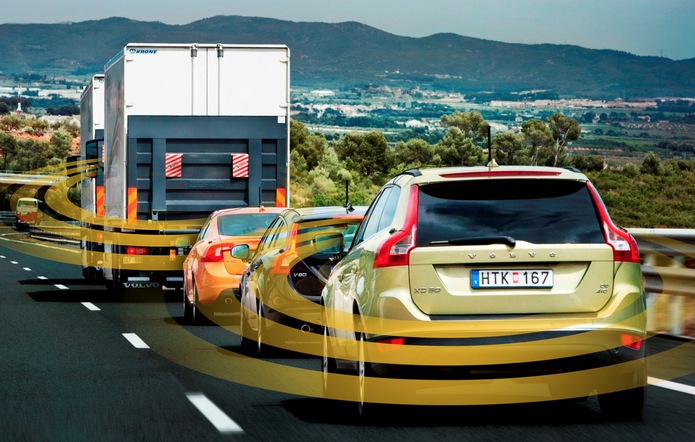I blogged recently about the review of the law governing autonomous vehicles (AVs) that is being carried out by the British Law Commission. One aspect not considered in the consultation document is the implications for vehicle connectivity. I have submitted a response to the consultation to make the following points.
Adaptive Cruise Control, available in some current production vehicles, adjusts the gap to the vehicle in front using sensor data to vary speed. Connected (or Cooperative) Adaptive Cruise Control (CACC), an emerging technology, takes data from vehicles further ahead using vehicle-to-vehicle (V2V) communications, which allows shorter headways and attenuates traffic disturbance to achieve smoother flow. The shorter the headway, the less scope for driver control. In the limit, CACC allows platooning of vehicles on inter-urban roads – ‘road trains’ involving vehicles in close proximity with a lead driver in control. The postulated benefits of platooning include better fuel economy and decreased emissions resulting from lower aerodynamic drag, improved traffic flow and capacity, and lower labour costs. A number of truck manufacturers have initiated trials and more are planned. The 2016 European Truck Platooning Challenge involved six manufacturers sending platoons from starting points in five different countries to end at Rotterdam, gaining valuable practical experience.
Much of the past impetus for the development of connected vehicles came from research funding provided by the US Department of Transportation. The main motive was to improve safety through vehicles exchanging data about speed and location, and vehicles acquiring data from roadside infrastructure about road conditions. There are two competing telecoms technologies under consideration: short-range WiFi for V2V being developed by the car manufacturers for platooning; and a system based on the next generation 5G mobile phone technology, to be installed in both vehicles and infrastructure, and able to signal at longer range.
Unlike truck drivers, the generality of drivers of AVs would be able to choose the gap to the vehicle in front. It is not clear why, without an incentive, they would choose a gap smaller than that with which they are comfortable, which may not be very different from current headways. Accordingly, to increase road capacity by reducing headway there would need to be some incentive that would impact on individual drivers. This might be a road user charging regime that charged on the basis of the length of carriageway effectively occupied. Another kind of incentive to reduce headway would be dedicated lanes that are less congested and faster flowing than other lanes, analogous to High Occupancy Vehicle lanes on US highways. Acceptable incentives would be needed if manufacturers were to go beyond equipping vehicles with the existing Adaptive Cruise Control. If manufacturers are to be held be responsible for the safe functioning of AVs, adding V2V or vehicle-to-infrastructure connectivity (V2I) to reduce headway would exacerbate this responsibility by introducing functionality that depends on that of other manufacturers and suppliers, and that increases the risk of security breaches.
More generally, connected vehicles operating at short headways would require reconsideration of the safety regime concerned with the crashworthiness of individual vehicles. A system of connected vehicles would require consideration of fault modes at system level, for instance the consequences of faults in individual vehicles in a platoon or faults in connectivity, including faults from hostile interventions. It would not be surprising if there were trade-offs between headway and safety that limited possible increases in effective road capacity.
The current industry-wide technological thrust is directed towards vehicle autonomy, not connectedness. The logic is that the general application of V2V connectivity would need to follow on from the successful adoption of vehicle autonomy – because the benefits of such connectivity largely depend on response times of connected vehicles that are faster than achievable by human drivers. There would then be a question of whether access to certain classes of roads should be limited to vehicles equipped with V2V technology. However, the efficiency gains from such dedicated infrastructure use would depend on widespread adoption of V2V communications, for which, as noted, there may be a lack of incentive for vehicle manufacturers to develop.
Although the potential of connectedness is unclear at present, it would be sensible for a new legal regime to allow for this possibility. On the railway, statutory regulations place a duty on infrastructure managers and operators to develop safety management systems, as well as a duty on operators to work together to ensure safety. However, the railway is a closed system that can be used only by authorised operators, whereas roads are generally open to all qualified users.
One approach would be to regard V2V and V2I connectivity as simply extensions of visual detection of other vehicles and roadside signs and signals. From this perspective, the legal framework for AVs may not need to be modified to deal with connected vehicles. On the other hand, it is arguable that the absence of some kind of system-level safety requirement would be incompatible with public expectations in the event of a crash involving numbers of connected AVs.

